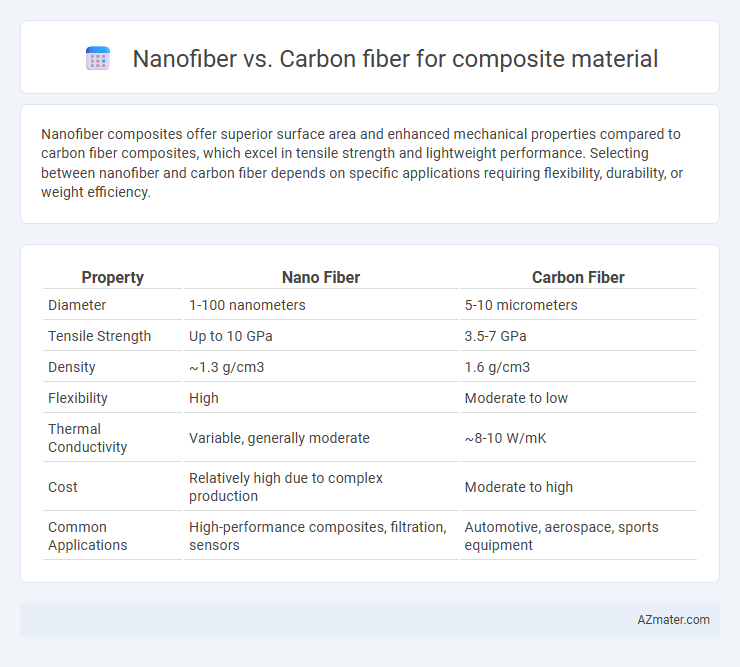Nanofiber composites offer superior surface area and enhanced mechanical properties compared to carbon fiber composites, which excel in tensile strength and lightweight performance. Selecting between nanofiber and carbon fiber depends on specific applications requiring flexibility, durability, or weight efficiency.
Table of Comparison
| Property | Nano Fiber | Carbon Fiber |
|---|---|---|
| Diameter | 1-100 nanometers | 5-10 micrometers |
| Tensile Strength | Up to 10 GPa | 3.5-7 GPa |
| Density | ~1.3 g/cm3 | 1.6 g/cm3 |
| Flexibility | High | Moderate to low |
| Thermal Conductivity | Variable, generally moderate | ~8-10 W/mK |
| Cost | Relatively high due to complex production | Moderate to high |
| Common Applications | High-performance composites, filtration, sensors | Automotive, aerospace, sports equipment |
Introduction to Composite Materials
Composite materials combine two or more distinct substances to achieve superior properties unattainable by individual constituents, significantly enhancing strength-to-weight ratios. Nanofibers offer exceptional surface area and nanoscale reinforcement, improving mechanical, thermal, and electrical properties at microscopic levels. Carbon fibers provide high tensile strength and stiffness, crucial for structural applications requiring lightweight and durable composites in aerospace, automotive, and sporting goods industries.
Overview of Nanofiber Technology
Nanofiber technology revolutionizes composite materials by offering ultra-fine fibers with diameters in the nanometer range, significantly enhancing mechanical strength, surface area, and electrical properties compared to traditional carbon fibers. These nanofibers improve matrix-fiber bonding, increase toughness, and boost thermal stability within composite structures. Widely used in aerospace, automotive, and electronics industries, nanofiber composites enable lightweight yet highly durable materials optimized for advanced engineering applications.
What is Carbon Fiber?
Carbon fiber is a high-strength, lightweight composite material made from thin strands of carbon atoms bonded in a crystalline structure, offering exceptional tensile strength and stiffness. It is widely used in aerospace, automotive, and sporting goods industries due to its superior strength-to-weight ratio and resistance to corrosion and fatigue. In comparison, nanofibers are much smaller-scale fibers that can enhance composite materials by improving mechanical properties and surface area at the nanoscale, but carbon fiber remains the preferred choice for structural applications requiring high load-bearing capacity.
Mechanical Properties: Nanofiber vs Carbon Fiber
Nanofiber composites exhibit exceptional tensile strength and flexibility due to their high surface area-to-volume ratio, enhancing interfacial bonding within the matrix. Carbon fiber composites provide superior stiffness, modulus, and fatigue resistance, making them ideal for high-load applications. While nanofibers improve impact resistance and toughness, carbon fibers dominate mechanical performance in aerospace and automotive industries due to their optimized strength-to-weight ratio.
Weight and Density Comparison
Nanofibers exhibit significantly lower weight and density compared to carbon fibers, making them ideal for ultra-light composite materials. Carbon fibers typically have a density around 1.75-1.93 g/cm3, whereas nanofibers can reach densities as low as 0.9 g/cm3, enabling more lightweight structural components. This density difference directly impacts the overall weight of composite materials, with nanofiber composites offering superior weight reduction for aerospace and automotive applications.
Durability and Longevity Analysis
Nano fibers exhibit superior durability in composite materials due to their high surface area-to-volume ratio, which enhances interfacial bonding and resistance to mechanical fatigue. Carbon fibers are renowned for their exceptional tensile strength and stability, providing long-term structural integrity in composites under varying environmental conditions. Comparative longevity analysis reveals that nano fiber composites excel in resisting micro-crack propagation, while carbon fiber composites maintain overall stiffness and fracture toughness over extended usage.
Manufacturing Processes and Scalability
Nano fiber production typically involves electrospinning, which offers precise control over fiber diameter but faces challenges in scalability due to slow throughput and complex equipment. Carbon fiber manufacturing relies on processes like pyrolysis of polyacrylonitrile (PAN) or pitch precursors, enabling high-volume production with established industrial methods. While carbon fiber composites benefit from widely scalable manufacturing and cost-efficiency, nano fiber composites remain specialized with potential for enhanced material properties but limited large-scale fabrication.
Applications in Various Industries
Nanofibers, characterized by their high surface area and nanoscale diameter, enhance composite materials in electronics, filtration, and biomedical applications by providing superior mechanical strength and improved electrical conductivity. Carbon fibers, known for their exceptional tensile strength and lightweight nature, dominate aerospace, automotive, and sporting goods industries, delivering high-performance structural components and weight reduction. Both nanofiber and carbon fiber composites contribute to the development of advanced materials, but carbon fibers remain the preferred choice for load-bearing applications requiring stiffness and durability.
Environmental Impact and Sustainability
Nano fiber composites offer enhanced environmental benefits due to their lightweight properties, which reduce material consumption and energy use during production and transportation. Carbon fiber composites, while strong and durable, have a higher environmental footprint because of energy-intensive manufacturing and challenges in recycling. Sustainable development favors nano fiber composites for their potential in biodegradability and lower carbon emissions throughout the lifecycle.
Future Trends in Composite Material Development
Nano fiber and carbon fiber are at the forefront of composite material innovation, with nano fibers offering superior surface area and enhanced mechanical properties at the molecular level. Emerging trends emphasize hybrid composites combining nano fibers with carbon fibers to achieve lighter, stronger, and more durable materials for aerospace and automotive industries. Advanced manufacturing techniques such as electrospinning and 3D printing are accelerating the integration of nano fibers, enabling scalable production and novel applications in next-generation composites.

Infographic: Nano fiber vs Carbon fiber for Composite material
 azmater.com
azmater.com